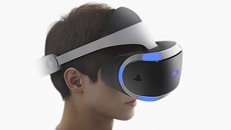Raevenlord
News Editor
- Joined
- Aug 12, 2016
- Messages
- 3,755 (1.15/day)
- Location
- Portugal
| System Name | The Ryzening |
|---|---|
| Processor | AMD Ryzen 9 5900X |
| Motherboard | MSI X570 MAG TOMAHAWK |
| Cooling | Lian Li Galahad 360mm AIO |
| Memory | 32 GB G.Skill Trident Z F4-3733 (4x 8 GB) |
| Video Card(s) | Gigabyte RTX 3070 Ti |
| Storage | Boot: Transcend MTE220S 2TB, Kintson A2000 1TB, Seagate Firewolf Pro 14 TB |
| Display(s) | Acer Nitro VG270UP (1440p 144 Hz IPS) |
| Case | Lian Li O11DX Dynamic White |
| Audio Device(s) | iFi Audio Zen DAC |
| Power Supply | Seasonic Focus+ 750 W |
| Mouse | Cooler Master Masterkeys Lite L |
| Keyboard | Cooler Master Masterkeys Lite L |
| Software | Windows 10 x64 |
Many research firms' numbers have shown that VR product sales in 2016 have been weaker than originally expected due to both high product costs and lack of content. No-one has yet seen VR's killer app, after all, and I know I'd love to see another Halo-like product to drive awareness on the VR platforms like it did on the original Xbox.
All of the above lead towards Google's Daydream View, HTC's Vive, Oculus Rift and Samsung Electronics' Gear VR having all achieved sales that are not even close to previously-set market expectations, with even the current mainstream poster-boy for VR, Sony's PSVR, showing adoption numbers that are as lowly as low can be. Even in their home-field, Japan, a country known for being filled with tech-savvy and tech-crazed customers, only 0.7% of the existing PS4 and PS4 Pro user-base has made the jump for a VR headset.


Consider the amount of studios that have already committed themselves towards the development of VR/AR games (such as Crytek with their Robinson: The Journey and 4A Games with their in-development ARKTIKA.1). Then consider that demand for those pieces of software - and VR headsets themselves - has been weakening recently. The supply chain has already invested heavily into related developments: vendors such as Acer and Asustek Computer have shifted major resources towards development of VR/AR devices for 2017 and are expected to release them in early 2017. However, some market watchers are concerned that the VR/AR ecosystem may not be mature enough to contribute much to the players - and excess offerings for a low-penetration market will invariably lead to losses and, potentially, bankruptcy.
VR/AR technologies also require more improvement in order to stimulate demand from both the consumer and enterprise sectors. It will take more time before the VR/AR market may begin enjoying robust growth, and such a slower-than-expected development is putting pressure on firms that have invested resources into related development. Asustek will launch an all-in-one VR head-mounted device (HMD) in the third quarter of 2017, featuring built-in cameras, sensors and controllers. And for Q1 2017, Acer is planning to release a VR HMD based on the Windows Holographics platform that support mixed reality experience. The company has been aggressively cooperating with VR players, having invested in the IMAX VR Content Fund and established a joint venture with Sweden-based game design company Starbreeze to develop StarVR HMD.
However, these companies are relatively large and have varied streams of income, and a lower than expected adoption of VR is unlikely to bring their budgets into the red line. However, many smaller companies have sprung up since the availability of VR and AR as a market, intent on carving themselves a pie of it. For the smaller companies banking on VR and AR to power both their content and their revenues, wrong (maybe hopeful) forecasts of market value may yet prove their financial undoing.
View at TechPowerUp Main Site
All of the above lead towards Google's Daydream View, HTC's Vive, Oculus Rift and Samsung Electronics' Gear VR having all achieved sales that are not even close to previously-set market expectations, with even the current mainstream poster-boy for VR, Sony's PSVR, showing adoption numbers that are as lowly as low can be. Even in their home-field, Japan, a country known for being filled with tech-savvy and tech-crazed customers, only 0.7% of the existing PS4 and PS4 Pro user-base has made the jump for a VR headset.


Consider the amount of studios that have already committed themselves towards the development of VR/AR games (such as Crytek with their Robinson: The Journey and 4A Games with their in-development ARKTIKA.1). Then consider that demand for those pieces of software - and VR headsets themselves - has been weakening recently. The supply chain has already invested heavily into related developments: vendors such as Acer and Asustek Computer have shifted major resources towards development of VR/AR devices for 2017 and are expected to release them in early 2017. However, some market watchers are concerned that the VR/AR ecosystem may not be mature enough to contribute much to the players - and excess offerings for a low-penetration market will invariably lead to losses and, potentially, bankruptcy.
VR/AR technologies also require more improvement in order to stimulate demand from both the consumer and enterprise sectors. It will take more time before the VR/AR market may begin enjoying robust growth, and such a slower-than-expected development is putting pressure on firms that have invested resources into related development. Asustek will launch an all-in-one VR head-mounted device (HMD) in the third quarter of 2017, featuring built-in cameras, sensors and controllers. And for Q1 2017, Acer is planning to release a VR HMD based on the Windows Holographics platform that support mixed reality experience. The company has been aggressively cooperating with VR players, having invested in the IMAX VR Content Fund and established a joint venture with Sweden-based game design company Starbreeze to develop StarVR HMD.
However, these companies are relatively large and have varied streams of income, and a lower than expected adoption of VR is unlikely to bring their budgets into the red line. However, many smaller companies have sprung up since the availability of VR and AR as a market, intent on carving themselves a pie of it. For the smaller companies banking on VR and AR to power both their content and their revenues, wrong (maybe hopeful) forecasts of market value may yet prove their financial undoing.
View at TechPowerUp Main Site
Last edited:




